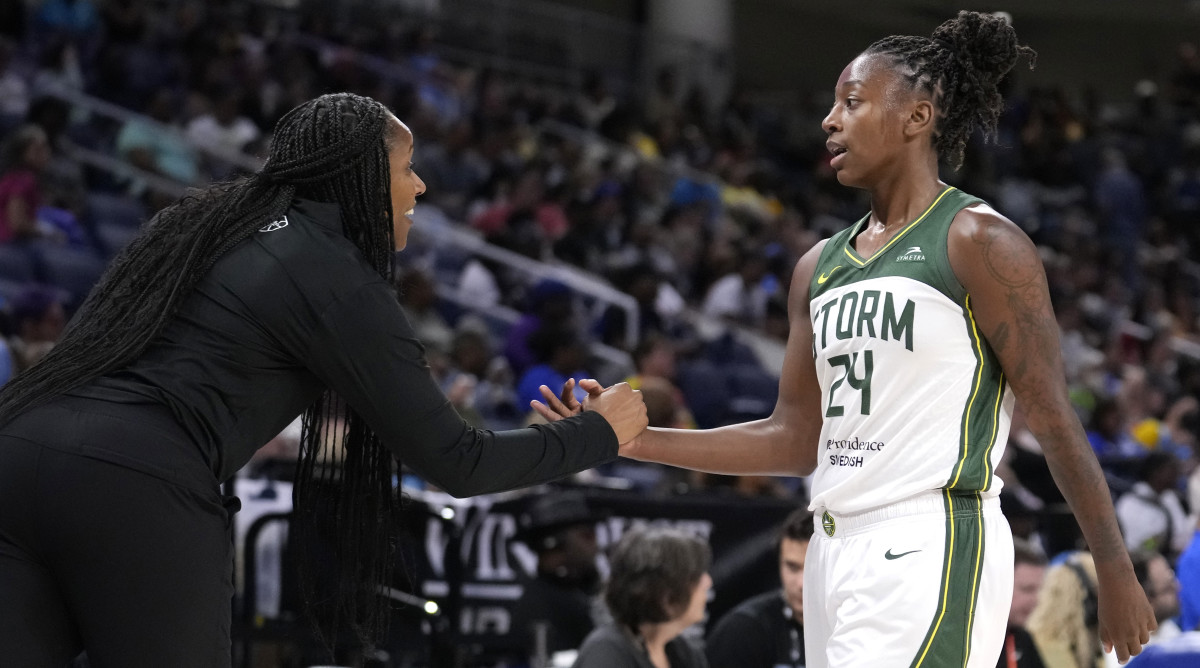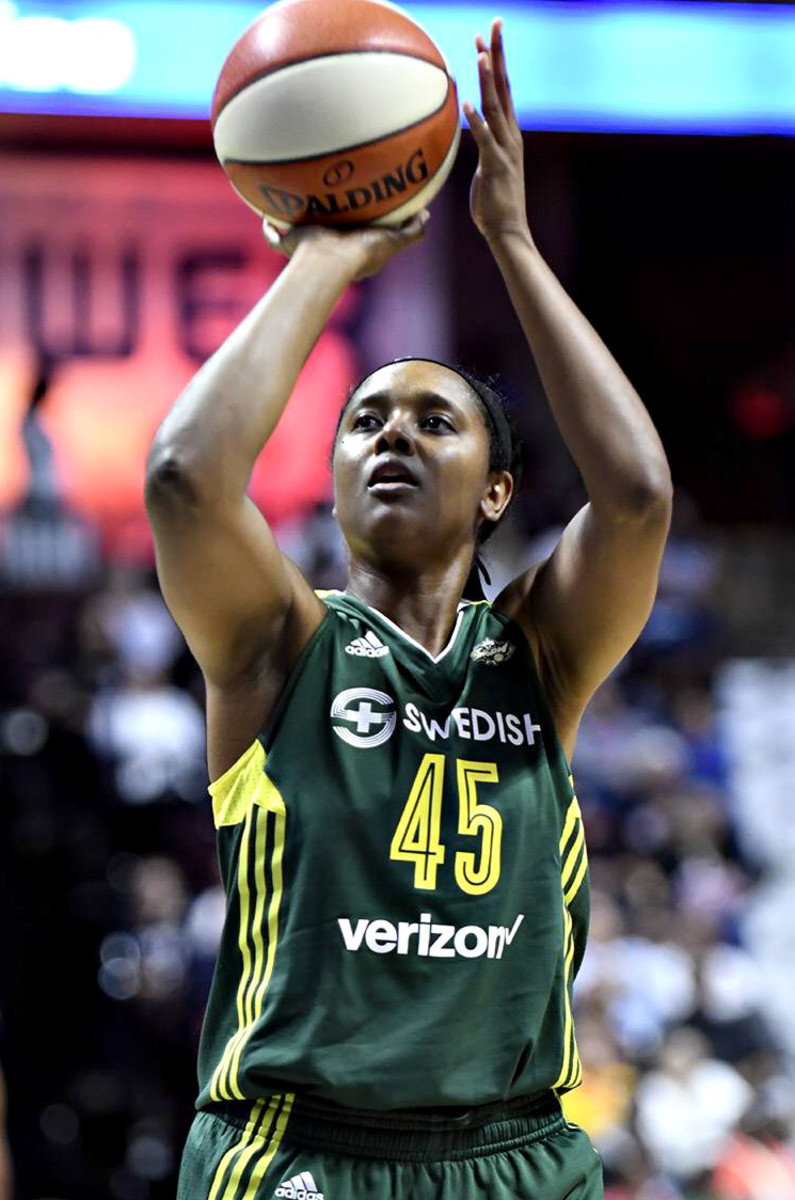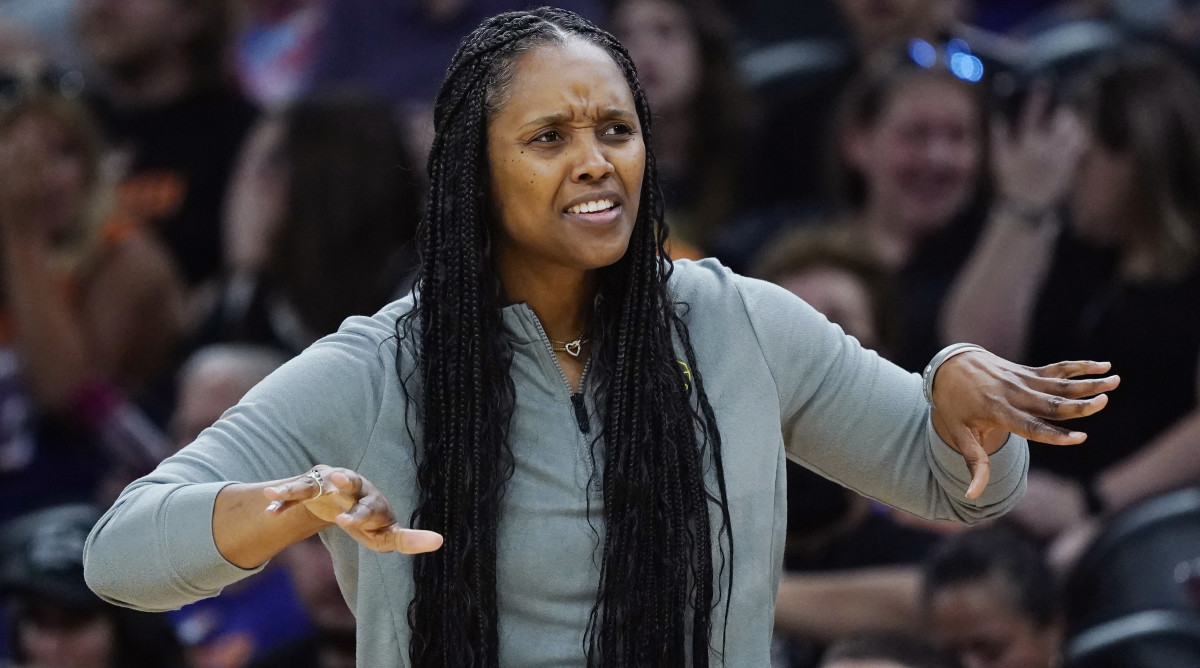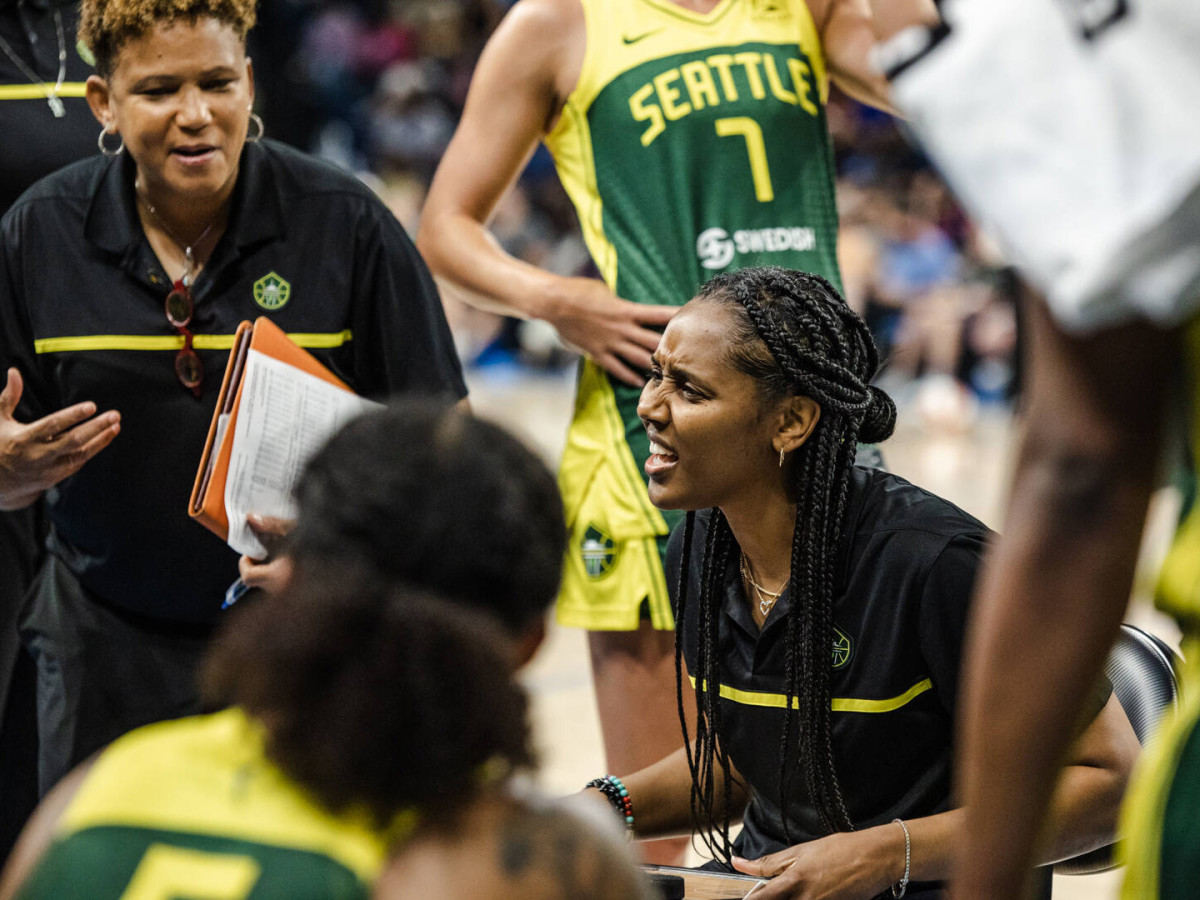The Storm Are Noelle Quinn’s Blank Canvas, and She’s Painting Intently

Wherever Noelle Quinn went, wherever basketball took her, from UCLA to WNBA stops in Minnesota, Los Angeles, Washington and Phoenix, she always came back home. No, not to Torrance, Calif., where she grew up. But to Seattle, her adopted base, where she played for the Storm in 2013 and ’14, left, came back for part of ’16, all of ’17 and all of ’18, retired, and returned once more, the next season, as an assistant coach.
In all those stops, Quinn immersed in the Tao of a distinct WNBA franchise. She didn’t just play with Sue Bird and Breanna Stewart; she watched them, studying them, their processes, up close. She saw community impact beyond basketball but also in basketball: tons of elite basketball, a system, a soul, a way of operating that netted four championships in one 17-season stretch. She came to learn one lesson above all. “There is a tradition here,” Quinn says, “that needs to be upheld.”
Every time she departed and came home, she compared her latest stop with her experiences in Seattle. The Storm felt like family. The Storm fit.

“This,” Quinn often tells herself, “is where you belong.”
She needed that sense—of fit, of purpose—this season more than ever. Because, after one season as an assistant and two seasons as Seattle’s associate head coach, Quinn took over for a mentor, Dan Hughes, early into 2021. She still had Bird, still had Stewart and also had current MVP candidate Jewell Loyd. The Storm were still a playoff team, in ’21 and ’22, before the retirement (Bird, after 20 seasons in Seattle), the departure (Stewart, to the Liberty) and the most extreme makeover for a franchise defined for decades by stability.
Now? Quinn might as well carry around paintbrushes. The canvas that is her basketball team is that blank. She’s starting to fill it in and started with upholding that tradition. “There’s a level of professionalism and approach that needs to be up there,” she says. “It’s just different here. We’ve set the tone and set the standard.” But she also knows her team is young, new to one another and, for the vast majority of players, new to Seattle and to her.
That can be energizing, the possibilities, the chance to imprint and alter the franchise that came to anchor Quinn’s itinerant hoops life. But it can be terrifying, too. Like whenever her mind drifts into the future, win-loss records, the tenuous existence of any coach. She understands she has to win. She believes that winning consistently will take time. So she shapes and coaches, paints and schemes, everything, everywhere, all at once. She says she’s grateful. She also says, “The weight is heavy.” The goal is impact, the best and right kinds of change.
“The word that comes to mind is fluid,” she says. But in that flexibility, in trying everything (a scheme, a rotation, a way to find Loyd, who’s averaging 24.1 points, bounties of shots) and failing often, Quinn found beauty and simplicity baked into what can seem to outsiders like an impossible task.
In some ways, a blank canvas makes this season more exciting than the last two. In 2021, Quinn was a first-time head coach, charged with coaxing a veteran team into contention, which made her more of a manager and less of an artist. Same for ’22.
Not that there’s anything wrong with a managerial approach. It’s what those seasons called for. This, though, is not that. She’s not a rookie coach. There aren’t many veterans to coax. But now, she’s a painter, her imprint not only obvious but critical, and for seasons beyond the current one. “This year,” she says, “it’s completely mine.”
The goal isn’t to “reinvent basketball.” The goal is to meld 12 WNBA seasons as a player and four as a coach with her growth, the Storm’s existing personnel and future aims. That’s how this experiment in creation began. How it’s going: not bad, all things considered. The Storm’s record isn’t worthy of any cartwheels just yet. They’re 9–21 through this season’s first 30 games, tied for the 10th-best/third-worst mark in the WNBA. But look a little closer. There are signs of optimism, even with the record: 5–5 in the previous 10 games, 5–2 in the past seven and 2–0 most recently.
This season, at least, Quinn will never finish the canvas that she’s painting. She may never finish, period. There’s no masterpiece here, only, if all goes well, the skeleton of one.

On a Thursday afternoon in June, players finish up another early-season practice at Royal Brougham Pavilion on the campus of Seattle Pacific University. The title banners hang on a wall nearby, from 2004, ’10, ’18 and ’20. Quinn wears neither of her championship rings, as players hoist extra jumpers and support staff stack folding chairs. Hip-hop blasting from a portable speaker the size of a minifridge renders clear thought or easy conversation impossible.
At midcourt, a crew sets up lighting and a folding table for lighthearted promo interviews. When they begin taping, they also illuminate the general Storm vibe: loose and light but grounded in focus, determination, improvement via not just practice but camaraderie fashioned in all forms. Seattle’s contingent of players from Australia—Ezi Magbegor, Jade Melbourne, Sami Whitcomb—sit at a table, where various teammates drop by to try out various foods from their homeland. Faces scrunch. Or light up. Either way, there’s connection, the early formation of bonds.
Still, it’s hard, weaving numerous aims together into something more cohesive. The complexity starts with juggling contrasting timelines that often stand in direct opposition to each other. There’s immediacy, in this season, in winning games and building momentum. Her legacy won’t just reflect her record; it will define it. “That’s the world, though,” Quinn says. “That’s what equates to success.” Whatever she makes out of that canvas matters, then, only in relation to what it yields. But to best position the Storm for future seasons, she must also consider how each decision made for long-term purposes impacts Seattle’s ability to win, right now. Her players are young and inexperienced. They’re also energetic, charismatic, driven.
Will the infusion of youth create the intended transformation, one unlike any women’s professional basketball season in Seattle has ever witnessed? Absolutely.
Will that, as she considered early into the season, mean wins, let alone more wins than expected, in 2023? She’s not sure. “That’s nerve-racking to me,” Quinn says. Now, weeks later, after the All-Star break, the answer has started to reveal itself. The infusion has meant victories … to a point.
All interested parties should understand what doesn’t matter to the Storm’s coach—perception; whether then, now or in the future. Anyone who might consider Seattle a lovable collection of underdogs should know Quinn has long identified as such. She is quiet and reserved by nature. She never talked much trash, whether as a new WNBA guard or a veteran. “Not my style,” she says. This was: She just played. She doesn’t boast, complain or go full bombast now. She just coaches. The approach is pragmatic, thorough and, yes, fluid. When Stewart chose to play elsewhere, Quinn’s first thought was “transition to progress.” Seattle, to that end, already had a contingency plan in place.
Drastic change started with honest appraisals. This team would never resemble last season’s WNBA semifinalists; they lost to Las Vegas, which ruined Bird’s fairy-tale ending and seized the title.
Next, Quinn drew on her experience. She thought back to her first year in Minnesota as a player, after the Lynx drafted her fourth. Her rookie class consisted of seven (!) players: They learned together, grew together, created a culture and a system, together. The franchise would win three titles after she left, all between 2011 and ’17. “We learned while playing together against well-oiled machines,” she says.
She also considered the madness of 2021, when Hughes retired after six games (citing the toll the work had taken on him). And she, Noelle Quinn, became an instant first-time head coach, only the seventh in Storm history. She survived and thrived through both of those scenarios. What could she apply to do the same again?
Connection, for starters. Schemes that centered on her best players’ strengths. Finding Loyd more shots. Work ethic, like the example her mother set, teaching for 35 years in Los Angeles, getting up, day after day, to shape the minds of kindergartners and second graders and sixth graders without complaint. And inspiration, the kind that coaches instilled in her, because, she thinks, they saw more in her than she saw in herself.
Hadn’t she steered the girls basketball team at her alma mater, Bishop Montgomery in Torrance, to four state championships, while playing basketball professionally? Made the McDonald’s All-American team? Stuck? Endured? Surpassed 1,000 career points? Became a coach? Shaped the Storm’s prolific offense? Assisted the Canadian national team?
Quinn had already made history, becoming one of three Black coaches and one of two Black female coaches in the WNBA. When reporters raised the significance in her introductory press conference, she read the names of every Black female head coach who came before her. She honored them. And she honored them in her own powerful, understated way; authentic, at her core.
Couldn’t she do the same with this blank canvas?

Quinn’s approach to the unprecedented nature of this season led her to counterintuitive places. Like, well, roller skating rinks. She pulls out her cellphone to pull up a picture of the skates her cousin in Los Angeles designed. They’re Air Jordans, 12 lows, custom, bright, sleek.
To continue her growth, Quinn took up roller skating. Even there, she took a clinical approach, starting with proper form on straightaways, then turns, then speed. Then she learned how to skate backward. This exercise might sound silly. It was not.
She made treadmill workouts and Pilates sessions part of her routine. She went to Senegal last December and hosted basketball camps. She saw tangible improvement from players in the workouts, which affirmed success in her approach. She also studied the history of her ancestors and found resilience, which bolstered confidence. Once back, she sat down more often at her piano and just played. She found this relaxing and mind-sharpening.
In shifting her brain into different spaces, in the laps and spills and jogs and songs, she found what she was searching for. Something like balance. Peace. Renewal. All elevated her energy for the enormous task ahead. All, she says, made her a better coach.
How? The Storm’s youth movement, for one. With younger players and systematic change and a culture to both maintain and imprint, she found herself repeating the same instructions day after day. The recharge eliminated any frustration that might have bubbled before it started bubbling. It also helped Quinn find more voice, speak more often, operate with sharper focus and pay greater attention to smaller details.
As the season approached, Quinn settled on the messaging she wanted to impart. Which was … less messaging and more at the same time. This wasn’t the “Leave No Doubt” theme of 2021 and ’22. Instead, she leaned into whatever lessons came up, immediately, hoping to elevate growth through an organic slant to a most-everything-is-new template. She spent time off the court around her players, especially the young ones and the new ones, to understand what motivated them—to understand them.
Only three players returned to Seattle’s roster from last season. One, at least, was Loyd. The Storm added Kia Nurse, a Canadian star coming off an ACL injury, in free agency. They signed Whitcomb, who starred for nearby Washington in college and became an instant fan favorite in her first stint with Seattle. Of the 16 players invited to training camp, 13 held five years or less of WNBA experience. Six were rookies, including Melbourne, an enticing point guard, and shooting guard Jordan Horston, the ninth pick in the WNBA draft.
Thirty games in, the results have been mixed but mostly positive. Loyd cannot be stopped. Her statistical averages beyond points per game—4.6 rebounds, 3.4 assists, 1.1 steals and even 0.4 blocks—would likely have won her MVP honors in better-record seasons. She may win anyway, which speaks to her special season and immense gifts.
Nurse has provided minutes off the bench, playing in every game and starting two-thirds of them. Whitcomb (8.7 points per game, 2.6 assists) has provided a steady presence in front of a home-home crowd. Forward Gabby Williams, back from injury, has stuffed stat sheets (8.4 points, on average, 3.6 rebounds, 3.8 assists, 1.5 steals) in limited duty. Meanwhile, Magbegor is nearly averaging a double double, as the Storm’s second-leading scorer (13.9 ppg) and top rebounder (8.1 per game).
As a collective canvas, Seattle can rebound (ranking fifth in the WNBA), shoot with precision (first), score prolifically from long range (third) and with precision from beyond the arc (fifth). The perpetual issue has been on defense. But again, the Storm are young and improving, as evidenced by a recent defensive uptick that twinned with more bench production—both indicative of growth.

Even better: Before the season, in how they built and who they signed, the Storm also retained cap flexibility for the climb back, which, it’s safe to say now, has at least begun. That is, whenever the blank canvas begins to yield the kinds of wins, seasons and regular playoff appearances that marked something of a franchise birthright but would never have lasted forever without a transformation of some sort.
After about two weeks of camp, Quinn says she stopped thinking big picture, at least momentarily. She needed to be present, to focus on games and the seasons ahead, shifting once more.
Quinn frames the machinations as “real opportunity.” Most coaches would say the same thing, but there’s something about how she says it, this understated, reserved coach stepping into what she really wants to voice, that indicates she believes what she is selling. She tries not to focus on the ancillary stuff, like how the season started, with four straight defeats, a lowlight to which only 31 teams had previously descended since the league’s inception (1997). Only six of those teams advanced to the postseason. Still, with Loyd shooting atop the list of league scoring leaders, with close losses and with potential that’s obvious but not likely to net a torrid victory stretch, real opportunity seems like a good place to start.
After the ugly stretch at the beginning of the season, which owed in part to the league’s most difficult schedule, Seattle won three of its next four, turning real opps into real gains in real time. The obvious improvement began shortly after that. Quinn continued to tweak. How could she create more shots for Loyd? How could she simplify the endless fluidity into something more lasting? How could she build on the foundation she’s creating?
She still hated losing, still knew she had to win. But part of filling in her canvas meant redefining what “wins” were. Progress came in all forms and sizes; growth was culled in a million different ways. In some ways, her real opportunity is also a rare one. How many coaches get to play in, immerse in and grow up in a culture like the one the Storm established? How many of those then get to lead a dramatic transformation? “That’s right,” Quinn says. “It’s challenging. It stretches me. But that’s where I find growth.”
She’s still repeating herself, a third of the way into this season of great unknown and great promise. But she’s ready for that. She’s psyched for that. She has the piano and her Jordan skates at the ready, if necessary. But for now, she simply tells herself, “If [my players] don’t get it today, I know they will tomorrow.” Little victories for transformative change. That’s how it starts. How it builds. And, maybe, how that canvas morphs into another banner hanging on the wall.
